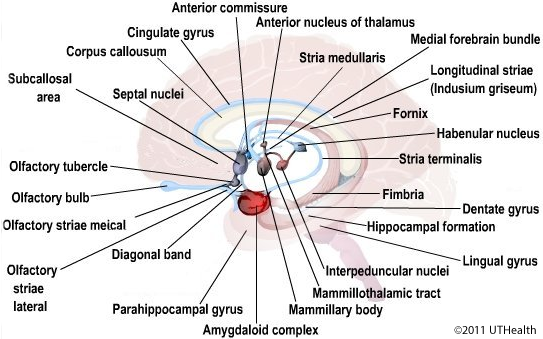Lab 11 - The Limbic System - Introduction
Purpose:
 Before examining the general anatomy of the limbic system, it is important to note that the use of the term limbic system is a designation used for descriptive purposes only. It is difficult, if not impossible, to find anatomical or physiological justification for lumping a diverse, multifunctional collection of cortical areas and subcortical structures together as the limbic system. Historically, the term "limbic system" derives from the concept of a "limbic lobe" that was presented by the French anatomist Broca. The word limbic refers to a border or fringe. Thus, the term was used to designate neural tissue that surrounds the brain stem and also lies beneath the neocortex. Functionally, structures of the limbic system are important in mediating emotional expression and behavior, and have been implicated in learning and memory in many animals including human. One limbic structure, the hippocampus, is particularly important clinically because it can be the primary focus for the generation of abnormal electrical discharges associated with epilepsy. Since the intrinsic neural circuitry of the hippocampus is known in considerable detail, the structure has also been used as a general model to study synaptic plasticity.
Before examining the general anatomy of the limbic system, it is important to note that the use of the term limbic system is a designation used for descriptive purposes only. It is difficult, if not impossible, to find anatomical or physiological justification for lumping a diverse, multifunctional collection of cortical areas and subcortical structures together as the limbic system. Historically, the term "limbic system" derives from the concept of a "limbic lobe" that was presented by the French anatomist Broca. The word limbic refers to a border or fringe. Thus, the term was used to designate neural tissue that surrounds the brain stem and also lies beneath the neocortex. Functionally, structures of the limbic system are important in mediating emotional expression and behavior, and have been implicated in learning and memory in many animals including human. One limbic structure, the hippocampus, is particularly important clinically because it can be the primary focus for the generation of abnormal electrical discharges associated with epilepsy. Since the intrinsic neural circuitry of the hippocampus is known in considerable detail, the structure has also been used as a general model to study synaptic plasticity.
Objectives:
At the end of the exercise you should be able to:
- Identify the major and related structures of the limbic system.
- Describe the relationship between these structures.
- Describe the general functions of these structures.

